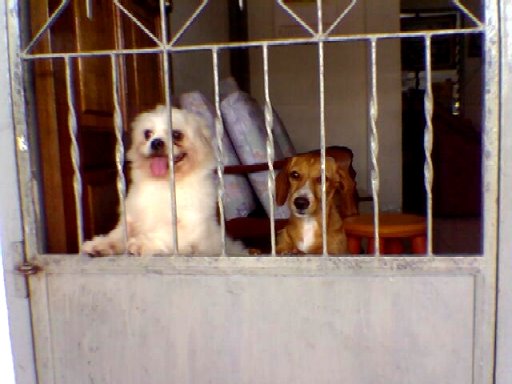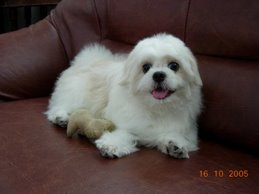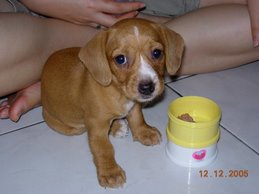Using Plastic Or Wire Crates In Crate Training Puppies Successfully
People who don't know any better, often think that crate training puppies is somehow mean and unkind. In reality, this kind of training only helps to keep the puppy safe. Your household will run smoothly without puppies underfoot, and it also becomes a place of refuge for the pup.
Even before you acquire a puppy you should consider which type kennel in which you would prefer to keep your dog secure. There are basically two types, wire and plastic. Each have their own merits and each will do the job. It is a personal choice. Some say that the plastic gives the puppy a greater feeling of security and of being in his "den", which is something they like.
Make the pups "den" a comfortable place for him to spend time. Food and water are not necessary in there. Keep anything about the crate from making scary noises or rattling any at all. This will frighten him and he may associate that feeling with his crate and refuse to go there.
Be sure to select the right sized crate for your puppy. If it is too large, he will use far corners for his potty and your efforts will fail, creating worse problems. If it is more economical to purchase a slightly larger one, be sure you can safely add a divider panel to it to create a smaller space. Puppies instinctively do not want to mess in their bedding areas. Use that to your advantage.
There should be no food or water in the crate, only a soft cloth for snuggling, if desired, and a few safe chew toys. Puppies do love to chew anything they can get to. Make a schedule for crating the puppy based around his feeding and watering times. Puppies are fed several times a day so about thirty to forty minutes after feeding and watering, take him outside to "do his duty". When he does, be sure to praise him greatly.
These furry little critters of eight or nine weeks can tolerate crating for up to seven or eight hours but it is not suggested that that be the norm, other than at night. For most times, a span of up to six hours can be well tolerated by Fido. Never use the crate as a place of punishment.
If it is possible to spend a few days of almost constant attention on the puppy in the beginning, that would be excellent. When you must go to work or leave the house for errands, if he has been taught the beginnings of good potty manners, he will be able to "hold it" for longer than you think. Try not to leave him kenneled for extended lengths of time. Be sure he gets out and has lots of exercise and attention. He will love you all the more for it.
When all is said and done, crate training puppies is a very effective way to teach your pup the rules of his life with you and your family. The crate will be used throughout his life to keep him and your home safe and secure. The rewards will be big, wet, sloppy kisses and a true friend forever.
Even before you acquire a puppy you should consider which type kennel in which you would prefer to keep your dog secure. There are basically two types, wire and plastic. Each have their own merits and each will do the job. It is a personal choice. Some say that the plastic gives the puppy a greater feeling of security and of being in his "den", which is something they like.
Make the pups "den" a comfortable place for him to spend time. Food and water are not necessary in there. Keep anything about the crate from making scary noises or rattling any at all. This will frighten him and he may associate that feeling with his crate and refuse to go there.
Be sure to select the right sized crate for your puppy. If it is too large, he will use far corners for his potty and your efforts will fail, creating worse problems. If it is more economical to purchase a slightly larger one, be sure you can safely add a divider panel to it to create a smaller space. Puppies instinctively do not want to mess in their bedding areas. Use that to your advantage.
There should be no food or water in the crate, only a soft cloth for snuggling, if desired, and a few safe chew toys. Puppies do love to chew anything they can get to. Make a schedule for crating the puppy based around his feeding and watering times. Puppies are fed several times a day so about thirty to forty minutes after feeding and watering, take him outside to "do his duty". When he does, be sure to praise him greatly.
These furry little critters of eight or nine weeks can tolerate crating for up to seven or eight hours but it is not suggested that that be the norm, other than at night. For most times, a span of up to six hours can be well tolerated by Fido. Never use the crate as a place of punishment.
If it is possible to spend a few days of almost constant attention on the puppy in the beginning, that would be excellent. When you must go to work or leave the house for errands, if he has been taught the beginnings of good potty manners, he will be able to "hold it" for longer than you think. Try not to leave him kenneled for extended lengths of time. Be sure he gets out and has lots of exercise and attention. He will love you all the more for it.
When all is said and done, crate training puppies is a very effective way to teach your pup the rules of his life with you and your family. The crate will be used throughout his life to keep him and your home safe and secure. The rewards will be big, wet, sloppy kisses and a true friend forever.
About the Author:
Looking for more information about the steps to crate training, then visit TW Bell's site on how to pick the best dog crate for your animals needs.














.jpg)






.jpg)

0 comments:
Post a Comment